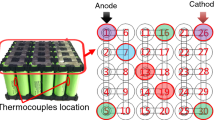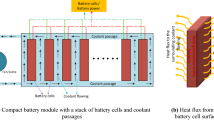Abstract
Li-ion batteries are widely used for battery electric vehicles (BEV) and hybrid electric vehicles (HEV) due to their high energy and power density. A battery thermal management system is crucial to improve the performance, lifetime, and safety of Li-ion batteries. The research on the heat dissipation performance of the battery pack is the current research hotspot in the electric vehicle industry. In this paper, battery modules and battery pack are simplified to heat source and semi-closed chamber, respectively. The field synergy principle and CFD technology were used to make a synergy analysis on its heat dissipation performance. Thermal flow fields of different air outlet modes were considered in this paper, and the results show that the heat dissipation performance of air-cooled battery pack increases with the improvement of the synergy degree between velocity field and temperature gradient field. Compared with other air outlet modes, the upper air outlet mode has the best cooling effect, when the inlet air flow rate is 0.444 m/s, the maximum temperature rise and the maximum temperature difference of heat source can be controlled at 7.01 °C and 3.08 °C.













Similar content being viewed by others
References
Vinodkumar E, Rotem et al (2011) Challenges in the development of advanced Li-ion batteries: a review[J]. Energy Environ Sci 4:3243–3262
Qian Z, Li et al (2016) Thermal performance of lithium-ion battery thermal management system by using mini-channel cooling.[J]. Energy Convers Manag 126:622–631
Ling Z, Wang F, Fang X et al (2015) A hybrid thermal management system for lithium ion batteries combining phase change materials with forced-air cooling[J]. Appl Energy 148:403–409
Saw LH, Ye Y, Tay AAO (2014) Electro-thermal analysis and integration issues of lithium ion battery for electric vehicles[J]. Appl Energy 131:97–107
Rao Z, Huo Y, Liu X, Zhang G (2015) Experimental investigation of battery thermal management system for electric vehicle based on paraffin/copper foam[J]. J Energy Inst 88(3):241–246
Bitsche O, Gutmann G (2004) Systems for hybrid cars[J]. J Power Sources 127(1–2):8–15
Karimi G, Li X et al (2013) Thermal management of lithium-ion batteries for electric vehicles[J]. Int J Energy Res 37(1):13–24
Cho GY, Choi JW, Park JH et al (2014) Transient modeling and validation of lithium ion battery pack with air cooled thermal management system for electric vehicles[J]. Int J Automot Technol 15(5):795–803
Park H (2013) A design of air flow configuration for cooling lithium ion battery in hybrid electric vehicles. J Power Sources 239:30–36
Xu XM, Zhao YQ (2012) Research on wind cooling disperse heat of micro electric vehicle power cabin[J]. Hangkong Dongli Xuebao/journal of Aerospace Power 27(7):1532–1536
Xu XM, He R (2013) Research on the heat dissipation performance of battery pack based on forced air cooling[J]. J Power Sources 240:33–41
Chen K, Chen Y, Li Z, Yuan F, Wang S (2018) Design of the cell spacings of battery pack in parallel air-cooled battery thermal management system. Int J Heat Mass Transf 127:393–401
Fan L, Khodadadi JM, Pesaran AA (2013) A parametric study on thermal management of an air-cooled lithium-ion battery module for plug-in hybrid electric vehicles. J Power Sources 238:301–312
Li X, He F, Ma L (2013) Thermal management of cylindrical batteries investigated using wind tunnel testing and computational fluid dynamics simulation. J Power Sources 238:395–402
Peng XB, Ma C et al (2019) Thermal performance investigation of an air-cooled lithium-ion battery pack considering the inconsistency of battery cells. Appl Therm Eng 153:596–603
Hong S, Zhang et al (2018) Design of flow configuration for parallel air-cooled battery thermal management system with secondary vent[J]. Int J Heat Mass Transf 116:1204–1212
Li X, He F, Zhang G, Huang Q, Zhou D (2019) Experiment and simulation for pouch battery with silica cooling plates and copper mesh based air cooling thermal management system[J]. Appl Therm Eng 146:866–880
Mohammadian SK, Zhang Y (2015) Thermal management optimization of an air-cooled Li-ion battery module using pin-fin heat sinks for hybrid electric vehicles[J]. J Power Sources 273:431–439
Mohammadian SK, Zhang Y (2017) Cumulative effects of using pin fin heat sink and porous metal foam on thermal management of lithium-ion batteries[J]. Appl Therm Eng 118:375–384
Guo ZY, Zhang CM (1992) Thermal drive in centrifugal fields-mixed convection in a vertical rotating cylinder. Int J Heat Mass Transf 35(7):1635–1644
Guo ZY, Li DY, Wang BX (1998) A novel concept for convective heat transfer enhancement. Int J Heat Mass Transf 41(14):2221–2225
Guo ZY, Tao WQ, Shah RK (2005) The field synergy (coordination) principle and its applications in enhancing single phase convective heat transfer. Int J Heat Mass Transf 48(9):1797–1807
Guo ZY (2001) Mechanism and control of convective heat transfer-coordination of velocity and heat flow fields. Chin Sci Bull 46(7):596–599
Amano RS (1984) Development of a turbulence near-wall model and its application to separated and reattached flows[J]. Numerical Heat Transfer 7(1):59–75
Acknowledgments
The authors appreciate the support of the National Natural Science Foundation of China (51875259), National key research and development program (2018YFC0810504), Foundation of State Key Laboratory of Automotive Simulation and Control (20180103).
Author information
Authors and Affiliations
Corresponding author
Ethics declarations
Conflict of interest
The authors declare that they have no conflict of interest.
Additional information
Publisher’s note
Springer Nature remains neutral with regard to jurisdictional claims in published maps and institutional affiliations.
Rights and permissions
About this article
Cite this article
Yang, Y., Xu, X., Zhang, Y. et al. Synergy analysis on the heat dissipation performance of a battery pack under air cooling. Ionics 26, 5575–5584 (2020). https://doi.org/10.1007/s11581-020-03676-5
Received:
Revised:
Accepted:
Published:
Issue Date:
DOI: https://doi.org/10.1007/s11581-020-03676-5




